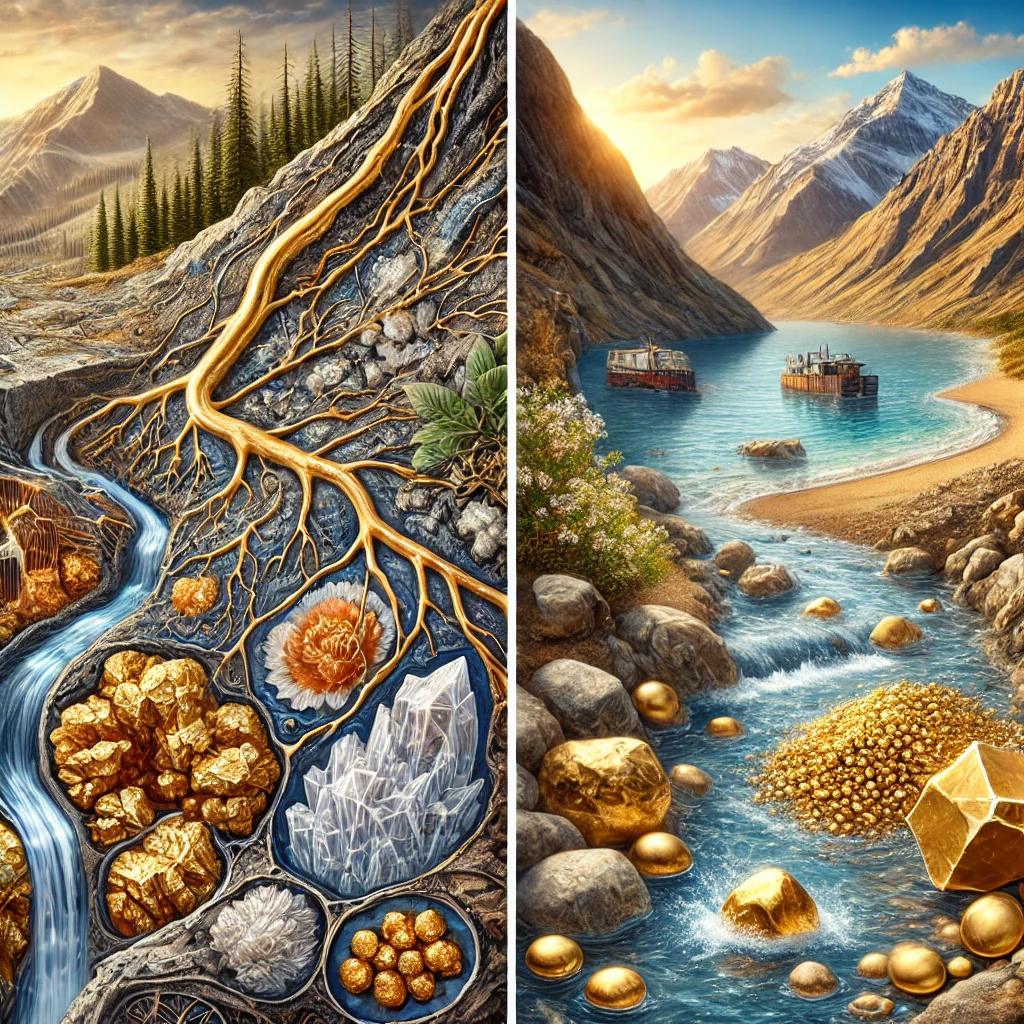
Understand Gold Deposit Formation and Identification to strike it rich. This guide provides insights into gold mining techniques and the geological processes behind gold formation. Read this article to inform yourself about how to identify gold-rich deposits fast. Start today while gold is at record prices!

Geology of Gold Formations and Deposits
Understand Gold Deposit Formation and Identification to Strike it Rich
Find Gold Deposits Using Geological Knowledge
Learn how Gold Deposit Formation and Identification can increase your chances of finding profitable gold in nature. Gold comes from geological processes that lead to the formation of gold-bearing veins. These veins contribute to both hard rock and placer gold deposits. The processes are crucial for effective gold prospecting.
Introducing Gold Deposits and Mineral Formation
Part 1: The Formation of Gold-Bearing Veins
Gold deposits are found in quartz veins, particularly in regions that have experienced significant volcanic activity, such as Southern Arizona. To understand the formation of these veins you start deep underground, tens of millions of years ago, during periods of intense volcanic activity where Gold Deposits formed across the expanse of Earth Time.
Volcanic Activity Creates Opportunities for Gold Deposit Formation
Volcanic Activity and Magma Chambers:
Magma, or molten rock from deep within the Earth, rises towards the surface, forming magma chambers.
When these chambers fill, pressure causes cracks to form in the overlying rock. If the pressure continues to build, the magma may erupt to the surface, creating a volcano. However, the focus here is on the cracks that form within the rock. That is where you will find the best opportunities to discover rich deposits of gold.
Hydrothermal Solutions and Mineral Deposition: Inside the magma, water and minerals are dissolved. As the magma cools, this water condenses, liquefies, and starts to move through the cracks.
Groundwater, which is nearly ubiquitous on Earth, also gets involved, being heated by the magma and rising through the cracks. This hot water, now rich in dissolved minerals, is known as a hydrothermal solution.
When hydrothermal solution cools while it moves through cracks in bedrock, it deposits dissolved minerals, a process known as precipitation. Over time, these minerals fill the cracks, forming veins composed primarily of quartz, along with metallic sulfides and occasionally gold and silver.
Types of Geological Formations Friendly for Finding Gold
Types of Deposits:
Veins: A fully filled crack forms a vein, which is a concentrated source of minerals, including gold.
Disseminated Deposits: When hydrothermal solutions move through porous bedrock, minerals can precipitate throughout the rock, creating a disseminated deposit. These deposits are typically lower in grade but larger in tonnage, making them suitable for large-scale mining operations.
Part 2: Identify Vein Characteristics and Sampling
Gold-bearing veins vary significantly in composition, even within the same deposit.
Observe the Vein Structure:
Different layers within a vein form during different events, that leads to variations in mineral content. For example, a section of quartz may be nearly pure, while another section might be rich in sulfides and other minerals.
Understand Gold Deposit Formation and Identification and a prospector’s opportunities increase for effective sampling. Separate samples should be taken from each distinct section to accurately assess the vein’s potential.
Sampling
Sampling Tips:
Sample each distinct material separately to understand the different mineralization events that occurred.
Sample altered wall rock adjacent to the vein if it shows signs of mineralization.
Part 3: The Origin and Types of Placer Gold
Placer gold is the result of the weathering and erosion of hard rock deposits, and it is found in various forms depending on its proximity to the source vein.
Residual Placer:
This type of placer deposit is found close to the source vein, where gold particles have weathered out of the vein and mixed with the surrounding soil. These deposits are ideal for metal detecting due to the relatively large size of the gold particles.
Eluvial Placer:
When gold particles move downhill from the residual placer, they form eluvial placers. These deposits are found on hillsides and identified by following the concentration of gold downhill.
Alluvial Placer:
Once the gold reaches a stream or river, it becomes part of an alluvial placer. These deposits form in the streambed and are often concentrated in natural traps within the bedrock, such as bends or irregularities.
Pay Streaks:
In streambeds, gold tends to follow a preferred path during floods, creating zones of high concentration known as pay streaks. These streaks are surrounded by sediments with much lower gold content.
Conclusion
As a gold prospector, understand the formation and characteristics of both hard rock and placer gold deposits to become knowledgeable on the essentials for effective prospecting. Recognize geological processes that create these deposits and learn how to identify and sample different types of veins and placers, increase your chances of finding gold.
Aurum Meum Academy: The Formation and Discovery of Gold Deposits!
How to Use a Sluice Box for Gold: Recovering Gold with Water





